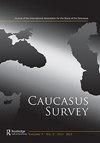Afterword
IF 0.4
Q3 AREA STUDIES
引用次数: 0
Abstract
The case of the gortsy mountaineers of the North Caucasus, who came to view the Transcaucasian Federative Democratic Republic (TDFR) as a viable state structure for Transcaucasia and sought to join it, represents one of the clearest examples of support for the TDFR. All of the contributions to this collection have dealt in one way or another with the question of who wanted the TDFR, examining the positions at different points in time of the influential political forces in the constituent nationalities, the small regional entities, and the key policy-makers of the Great Powers, who had all in some way – in some cases decades before the onset of the First World War and for decades after it – conceptualized of a federative or confederative framework of co-existence and cooperation for the nationalities of the North and South Caucasus. Many viewed such elements of interaction and interdependence as appealing and progressive, both in historical and cultural terms, and also as a modern path toward economic and political development. Insightfully, many viewed such a framework as more attractive than that of the nation-state for the region’s nationalities. And while the appeal for a federative arrangement had grassroot support, a key issue that came to the fore as the result of the First World War, the collapse of the Russian Empire, and the subsequent establishment of de facto federative structures such as the Transcaucasian Commissariat and the Seim, was whether the constituent elements in these structures could or should declare independence from their former metropole, the Russian state, which was undergoing an existential crisis and revolutionary transformation that many found frightening. In this context the range of actors who viewed the independence of the TDFR as viable was more limited. In the Georgian case, the most powerful political party, the Social-Democratic Party, was split on this issue: Akaki Chkhenkeli and Noe Ramishvili became the most ardent promoters of independence, while the rest of the party merely acquiesced, as did other parties during the five weeks of the TDFR’s existence. In the Azerbaijani case, even though most of the political parties were sympathetic to Ottoman Turkey, they wanted the independence of the TDFR and rejected the idea of its incorporation into the Ottoman Empire. The Armenian political parties, too, especially the Dashnaks, opposed the TDFR, but were reluctant to part with it when faced with the option of taking on the Ottoman army all on their own, which, ultimately, they had to do. Although the three main nationalities of the Transcaucasus were divided among themselves and also vis-à-vis one another in their views towards the independence of the TDFR, the Ottoman Empire was the most explicit among the Great Powers in its support for such independence while it existed. The Ottomans had their reasons and motivations for doing this, even though their own political experience with federalism compelled them to oppose后记
北高加索的血腥登山者将外高加索联邦民主共和国视为外高加索可行的国家结构,并试图加入其中,这是支持外高加索联邦民主党的最明显的例子之一。对这一收藏的所有贡献都以这样或那样的方式处理了谁想要TDFR的问题,研究了各组成民族、小型地区实体和大国关键决策者中有影响力的政治力量在不同时间点的立场,他们在某种程度上——在某些情况下,在第一次世界大战爆发前的几十年和之后的几十年里——为北高加索和南高加索的民族建立了一个共存与合作的联邦或联盟框架。许多人认为,从历史和文化角度来看,这种互动和相互依存的元素具有吸引力和进步性,也是经济和政治发展的现代途径。许多人深刻地认为,对于该地区的民族来说,这样的框架比民族国家更有吸引力。虽然联邦安排的呼吁得到了基层的支持,但这一关键问题因第一次世界大战、俄罗斯帝国的崩溃以及随后建立的外高加索委员会和议会等事实上的联邦机构而凸显出来,这些结构中的组成部分是否能够或应该宣布从他们的前大都市俄罗斯国家独立,俄罗斯国家正在经历一场生存危机和革命变革,许多人对此感到恐惧。在这种情况下,认为TDFR的独立性可行的行为者范围更加有限。在格鲁吉亚的案件中,最强大的政党社会民主党在这个问题上出现了分歧:Akaki Chkhenkeli和Noe Ramishvili成为最热心的独立推动者,而该党其他人只是默许了,在TDFR成立的五周里,其他政党也是如此。在阿塞拜疆的案例中,尽管大多数政党都同情奥斯曼土耳其,但他们希望TDFR独立,并拒绝将其并入奥斯曼帝国的想法。亚美尼亚各政党,尤其是达什纳克人,也反对TDFR,但在面临独自对抗奥斯曼军队的选择时,他们不愿意放弃,最终他们不得不这样做。尽管外高加索的三个主要民族在对TDFR独立的看法上存在分歧,奥斯曼帝国是列强中最明确的,在其存在期间支持这种独立。奥斯曼人这样做有其原因和动机,尽管他们自己的联邦制政治经历迫使他们反对
本文章由计算机程序翻译,如有差异,请以英文原文为准。
求助全文
约1分钟内获得全文
求助全文
来源期刊

Caucasus Survey
Arts and Humanities-History
CiteScore
1.30
自引率
9.10%
发文量
4
期刊介绍:
Caucasus Survey is a new peer-reviewed, multidisciplinary and independent journal, concerned with the study of the Caucasus – the independent republics of Armenia, Azerbaijan and Georgia, de facto entities in the area and the North Caucasian republics and regions of the Russian Federation. Also covered are issues relating to the Republic of Kalmykia, Crimea, the Cossacks, Nogays, and Caucasian diasporas. Caucasus Survey aims to advance an area studies tradition in the humanities and social sciences about and from the Caucasus, connecting this tradition with core disciplinary concerns in the fields of history, political science, sociology, anthropology, cultural and religious studies, economics, political geography and demography, security, war and peace studies, and social psychology. Research enhancing understanding of the region’s conflicts and relations between the Russian Federation and the Caucasus, internationally and domestically with regard to the North Caucasus, features high in our concerns.
 求助内容:
求助内容: 应助结果提醒方式:
应助结果提醒方式:


